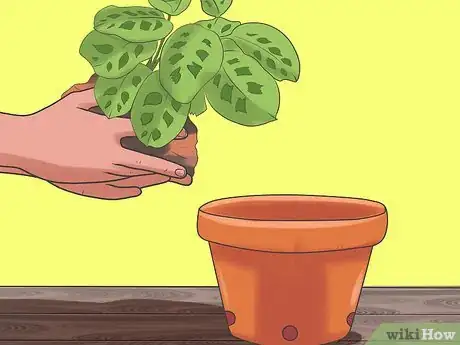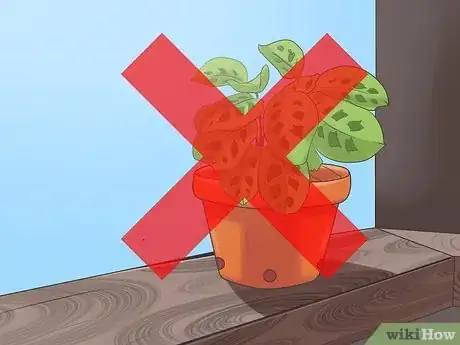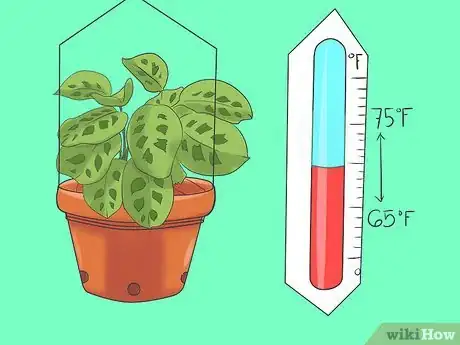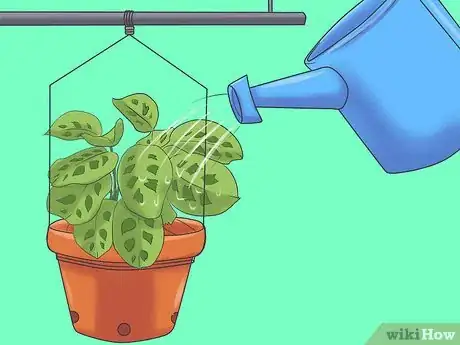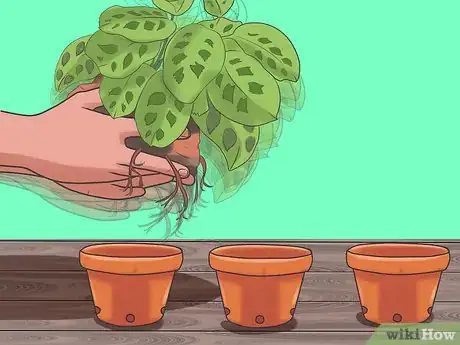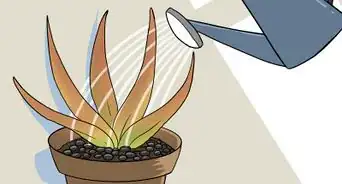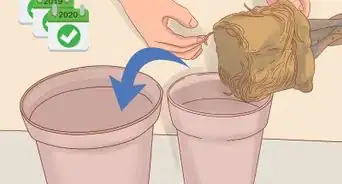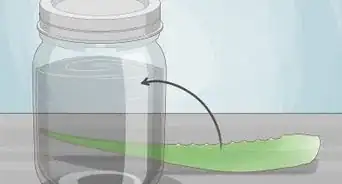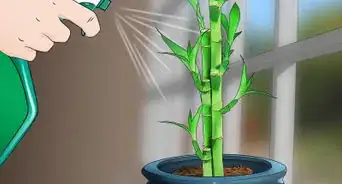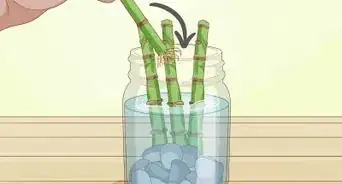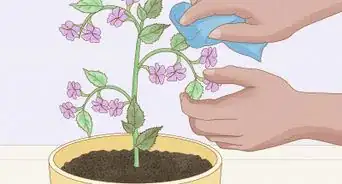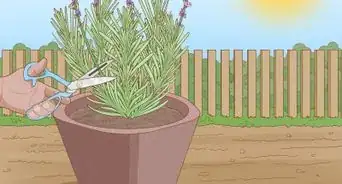This article was co-authored by Chai Saechao. Chai Saechao is the Founder and Owner of Plant Therapy, an indoor-plant store founded in 2018 based in San Francisco, California. As a self-described plant doctor, he believes in the therapeutic power of plants, hoping to keep sharing his love of plants with anyone willing to listen and learn.
wikiHow marks an article as reader-approved once it receives enough positive feedback. This article received 30 testimonials and 94% of readers who voted found it helpful, earning it our reader-approved status.
This article has been viewed 294,821 times.
Prayer plants, also known as Maranta leuconeura, are colorful perennials, ideal for rooms on the east or north side of your house where light levels are generally low. They have oval-shaped leaves splashed with bright green or pink blotches or stripes and can be grown in hanging pots or set on a table. In the evening and on cloudy days, prayer plants fold their leaves together like hands held in prayer. They can be grown outdoors in USDA Hardiness Zones 11 and 12 but are generally grown as houseplants everywhere.
Steps
Creating the Right Environment for Your Prayer Plant
-
1Put your plant in a shallow container that has drain holes in the bottom. Prayer plants are shallow-rooted plants. So, if they are planted in a deep container with too much soil below its roots, the soil stays soggy for too long and they will develop root rot. If you are potting your plant, always use a container with drain holes so the water can drain from the roots and the soil.
-
2Place your plant in indirect sunlight. You can hang or set your prayer plant near a window where it will get indirect sunlight. Never set your plant in direct sunlight as the sun will bleach the plant's leaves.Advertisement
-
3Hang your plant from the ceiling in a west or south facing room. Find a corner where direct light cannot reach the plant and hang it so it gets proper light exposure and grows properly.
- Proper light exposure results in a prayer plant with rich, green stems and colorful leaves.
- If your plant does not get enough light, the stems will grow long and spindly as they will naturally reach for more light.
-
4Keep the room temperature between 65 and 75 degrees Fahrenheit and a little humid. As prayer plants are tropical plants, they do not thrive when temperatures dip too far below 70 °F (21 °C). Colder temperatures and dry air will cause the prayer plant's leaves to shrivel and turn brown. Temperatures hotter than 75 °F (24 °C) can result in fewer leaves and long, spindly stems.
- Increase the humidity in the room with a humidifier or set a pan or dish filled with pebbles and water below the plant to increase the room's humidity.
- Do not put the prayer plant near heating or cooling vents or doorways where it will be exposed to extreme temperature fluctuations and drafts.
Maintaining Your Prayer Plant
-
1Water the prayer plant when the top of the potting soil is just starting to get dry. The soil should never be allowed to dry out completely. Not enough water and overwatering can cause the leaves to turn yellow and drop from the plant.
- If the leaves begin to turn yellow, water the plant less often if the soil is still wet or more often if the soil appears dry between waterings.
EXPERT TIPChai Saechao is the Founder and Owner of Plant Therapy, an indoor-plant store founded in 2018 based in San Francisco, California. As a self-described plant doctor, he believes in the therapeutic power of plants, hoping to keep sharing his love of plants with anyone willing to listen and learn.Plant Specialist
 Chai Saechao
Chai Saechao
Plant SpecialistPrayer plants, like maranta, need a lot of humidity. It can be difficult to care for prayer plants, but if you keep the soil moist at all times, they will do better. Some prayer plants are known to close and open up at night and move around.
-
2Use room-temperature water on the plant in the morning. This way, any water splashed on the leaves will be dry before evening. Cold tap water will chill your plant's roots and stress your plants, causing it to drop its leaves.
- Wet leaves and cooler nighttime temperatures also provide a breeding ground for leaf spot. If your plant develops brown or black spots on its leaves, snip the damaged leaves off at the base and throw them away.
-
3Fertilize your prayer plant every two weeks from early spring through to the fall. Use water-soluble houseplant fertilizer diluted to half-strength. The half-strength dilution rate for most water-soluble fertilizers is about ½ teaspoon per gallon of water but it could be slightly higher or lower. Check the label for the manufacturer's recommended dilution rate and reduce the amount by half.
- Aim for a balanced houseplant fertilizer with a ratio of 8-8-8 or 10-10-10.
- Too little fertilizer will cause the prayer plant to grow slowly or not at all. Too much fertilizer will burn the roots and cause the leaves to develop dry brown edges. When given the correct amount of fertilizer, prayer plants will have healthy green stems and leaves and grow vigorously.
-
4Make your own potting mix for your plant. Use a peat-based potting mix with a pH of 5.5 to 6.0 or mix two parts sphagnum peat moss, one part loamy soil, and one part perlite or coarse sand together.
- Stir all of the ingredients together until they are thoroughly mixed. Sphagnum peat moss, loamy soil, perlite, and coarse sand can be purchased at local garden centers.
- Purchase only clean, pre-packaged materials that have been commercially processed and are free of insects and weed seeds.
-
5Only repot the prayer plant in the spring or summer if it becomes pot-bound. When the container for the plant becomes full of roots, the potting mix dries out very quickly, causing the prayer plant to grow very slowly. This condition is called pot-bound.
- The new container for your plant should be only 1 to 2 inches wider than the old one. Put 1 inch of potting mix in the bottom of the new container, remove the prayer plant from the old container, place it in the new container and finish filling it with the potting mix. Once it's been repotted, water it generously to settle the soil around the roots.
-
6Divide the plant into smaller plants once it has been repotted. You can divide your prayer plant into several smaller plants by gently shaking the soil off the roots and working them apart. Each new plant should have a good mass of roots and several stems.
- Pot these new smaller plants up separately in small, shallow pots.
-
7Trim your plants two to three times a year to help them grow more vigorously. Use sharp scissors or hand pruners to snip a few of the stems back by a few inches. Make the cuts just above a leaf.
- New stems and leaves will grow from the growth nodes located below the cut where the remaining leaf is growing, so you will have lots of prayer plants to enjoy in your home.
Community Q&A
-
QuestionWhy are the leaves of my prayer plant curling inward along the sides of almost every leaf?
 Community AnswerThis may be the result of not watering enough. It doesn't have to be pathological though. The leaves change shape throughout the day, depending on the light they're exposed to and what sources it comes from.
Community AnswerThis may be the result of not watering enough. It doesn't have to be pathological though. The leaves change shape throughout the day, depending on the light they're exposed to and what sources it comes from. -
QuestionHow long does a prayer plant live?
 Community AnswerI have had mine for 40 years and it is still growing strong. I usually re-pot it every few years.
Community AnswerI have had mine for 40 years and it is still growing strong. I usually re-pot it every few years. -
QuestionCan I grow a prayer plant from a clipping?
 Community AnswerYes. I just clip off above a bottom leaf and place the cutting in water for a couple of weeks until you see roots.
Community AnswerYes. I just clip off above a bottom leaf and place the cutting in water for a couple of weeks until you see roots.
Things You'll Need
- Shallow container with drain holes
- Humidifier or dish with pebbles (optional)
- Fertilizer (water-soluble)
- Peat-based potting mix
- Sharp scissors or hand pruners
References
About This Article
To care for a prayer plant, keep it in a room with a temperature between 65 and 75 degrees Fahrenheit, since this will prevent it from drying out or wilting. Although you should never keep it in direct sunlight, make sure you place or hang your prayer plant near a window so it gets indirect sunlight. You should also add lukewarm water to the pot whenever its soil starts to get dry so it won’t dry out. In addition to water, feed your prayer plant with a water-soluble fertilizer diluted to half-strength every 2 weeks, which will give it all the nutrients it needs. If you want your plant to grow quicker, use sharp scissors or hand pruners to snip a few inches from some of the stems 2 or 3 times a year, since new stems and leaves will grow from the cuts. For more tips from our Gardening co-author, including how to pot new prayer plants from your offcuts, read on!
